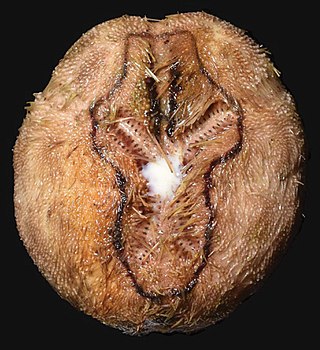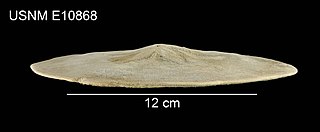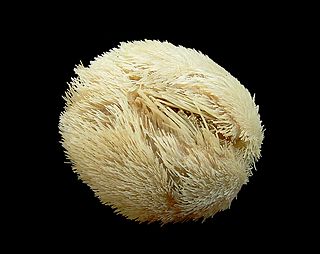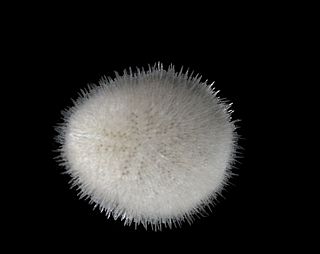
Sand dollars are species of flat, burrowing sea urchins belonging to the order Clypeasteroida. Some species within the order, not quite as flat, are known as sea biscuits. Sand dollars can also be called "sand cakes" or "cake urchins".

Meoma ventricosa, known by the common names cake urchin and red heart urchin, is a large species of sea urchin which lives in shallow waters in the Caribbean. It may reach a diameter of twenty centimeters and is covered in reddish-brown spines. It has both pentagonal radial symmetry and bilateral symmetry, giving it a sand-dollar appearance; however, two of its five sections are merged more closely than the others.

Clypeaster, common name "cake urchins" or "sea biscuits", is a genus of echinoderms belonging to the family Clypeasteridae.

Breynia australasiae is a species of sea urchins of the family Loveniidae, most commonly referred to as a heart urchin. Their armour is covered with spines. Breynia australasiae was first scientifically described in 1815 by Leach. This species is extremely common within the lagoon at Lord Howe I, although rarely sighted by divers along the New South Wales mainland. They grow up to 12 centimeters in length and can be found in waters of 0 to 10 meters deep.
Breynia desorii is a species of sea urchins of the family Loveniidae. Their armour is covered with spines. Breynia desorii was first scientifically described in 1851 by Gray.

Brissopsis luzonica is a species of sea urchins of the family Brissidae. Their armour is covered with spines. Brissopsis luzonica was first scientifically described in 1851 by Gray.
Cionobrissus revinctus is a species of sea urchins of the Family Brissidae. Their armour is covered with spines. Cionobrissus revinctus was first scientifically described in 1879 by Alexander Emanuel Agassiz.
Clypeaster aloysioi is a species of sea urchins of the family Clypeasteridae. Their armour is covered with spines. C. aloysioi was first scientifically described in 1959 by Brito.
Clypeaster amplificatus is a species of sea urchins of the family Clypeasteridae. Their armour is covered with spines. Clypeaster amplificatus was first scientifically described in 1922 by Koehler.
Clypeaster annandalei is a species of sea urchins of the family Clypeasteridae. Their armour is covered with spines. Clypeaster annandalei was first scientifically described in 1922 by Koehler.

Clypeaster chesheri is a species of sea urchins of the family Clypeasteridae. Their armour is covered with spines. Clypeaster chesheri was first scientifically described in 1970 by Serafy.
Clypeaster durandi is a species of sea urchins of the Family Clypeasteridae. Their armour is covered with spines. Clypeaster durandi was first scientifically described in 1959 by Cherbonnier.
Clypeaster elongatus is a species of sea urchins of the family Clypeasteridae. Their armour is covered with spines. Clypeaster elongatus was first scientifically described in 1948 by Hubert Lyman Clark.

Clypeaster euclastus is a species of sea urchins of the family Clypeasteridae. Their armour is covered with spines. Clypeaster euclastus was first scientifically described in 1941 by Hubert Lyman Clark.

Irregularia is an extant infraclass of sea urchins that first appeared in the Lower Jurassic.

Clypeasteridae is a family of sea urchins in the order Clypeasteroida. This family was first scientifically described in 1835 by the Swiss-American biologist Louis Agassiz.

Clypeaster rosaceus, the fat sea biscuit, is a species of sea urchin in the family Clypeasteridae. It occurs in shallow water in the western Atlantic Ocean and was first scientifically described in 1758 by Carl Linnaeus.

Clypeaster humilis is a species of sea urchin in the family Clypeasteridae. This species was first scientifically described in 1778 by the German biologist Nathanael Gottfried Leske. It occurs in the tropical Indo-Pacific region.

Clypeaster japonicus, the Japanese sea biscuit, is a species of sea urchin in the family Clypeasteridae. This species was first scientifically described in 1885 by the German zoologist Ludwig Heinrich Philipp Döderlein.

Echinocyamus pusillus, commonly known as the pea urchin or green urchin, is a species of sand dollar, a sea urchin in the family Fibulariidae, native to the northeastern Atlantic Ocean and the Mediterranean Sea. It buries itself in gravel or coarse sand at depths down to about 1,250 m (4,000 ft).











